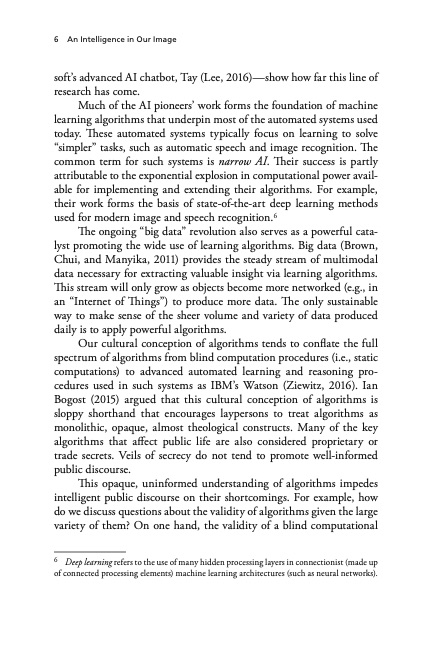
PDF Publication Title:
Text from PDF Page: 016
6 An Intelligence in Our Image soft’s advanced AI chatbot, Tay (Lee, 2016)—show how far this line of research has come. Much of the AI pioneers’ work forms the foundation of machine learning algorithms that underpin most of the automated systems used today. These automated systems typically focus on learning to solve “simpler” tasks, such as automatic speech and image recognition. The common term for such systems is narrow AI. Their success is partly attributable to the exponential explosion in computational power avail- able for implementing and extending their algorithms. For example, their work forms the basis of state-of-the-art deep learning methods used for modern image and speech recognition.6 The ongoing “big data” revolution also serves as a powerful cata- lyst promoting the wide use of learning algorithms. Big data (Brown, Chui, and Manyika, 2011) provides the steady stream of multimodal data necessary for extracting valuable insight via learning algorithms. This stream will only grow as objects become more networked (e.g., in an “Internet of Things”) to produce more data. The only sustainable way to make sense of the sheer volume and variety of data produced daily is to apply powerful algorithms. Our cultural conception of algorithms tends to conflate the full spectrum of algorithms from blind computation procedures (i.e., static computations) to advanced automated learning and reasoning pro- cedures used in such systems as IBM’s Watson (Ziewitz, 2016). Ian Bogost (2015) argued that this cultural conception of algorithms is sloppy shorthand that encourages laypersons to treat algorithms as monolithic, opaque, almost theological constructs. Many of the key algorithms that affect public life are also considered proprietary or trade secrets. Veils of secrecy do not tend to promote well-informed public discourse. This opaque, uninformed understanding of algorithms impedes intelligent public discourse on their shortcomings. For example, how do we discuss questions about the validity of algorithms given the large variety of them? On one hand, the validity of a blind computational 6 Deep learning refers to the use of many hidden processing layers in connectionist (made up of connected processing elements) machine learning architectures (such as neural networks).PDF Image | Intelligence in Our Image Risks of Bias and Errors in Artificial Intelligence

PDF Search Title:
Intelligence in Our Image Risks of Bias and Errors in Artificial IntelligenceOriginal File Name Searched:
RAND_RR1744.pdfDIY PDF Search: Google It | Yahoo | Bing
Cruise Ship Reviews | Luxury Resort | Jet | Yacht | and Travel Tech More Info
Cruising Review Topics and Articles More Info
Software based on Filemaker for the travel industry More Info
The Burgenstock Resort: Reviews on CruisingReview website... More Info
Resort Reviews: World Class resorts... More Info
The Riffelalp Resort: Reviews on CruisingReview website... More Info
| CONTACT TEL: 608-238-6001 Email: greg@cruisingreview.com | RSS | AMP |